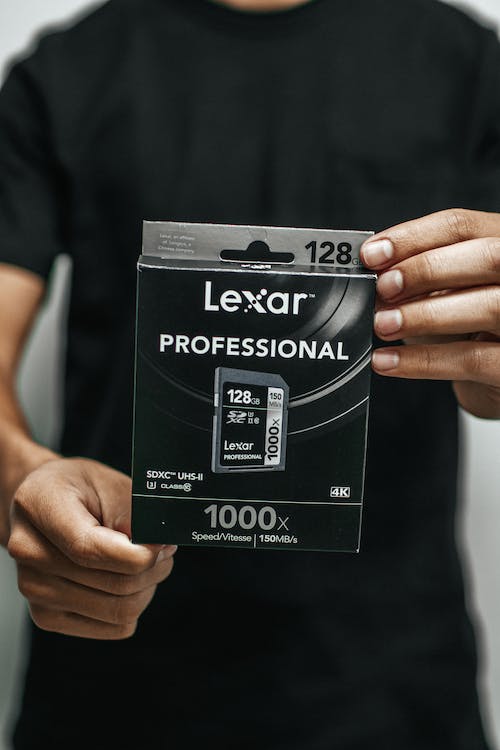SD cards are a popular flash memory storage device used by a variety of users. While many SD card owners will use their storage device without experiencing issues, SD card owners can also experience problems where resolving the situation is beyond the capabilities of most people. If the latter scenario describes your SD card ownership, you’ll be happy to hear that Data Savers LLC offers industry-leading SD card data recovery.
What is an SD Card?
Secure Digital (SD) cards are a family of standardized flash memory cards that are widely utilized by digital cameras, GoPro action sports cameras, many Android mobile phones (as an optional storage extension / file transfer / backup tool), and a variety of additional applications. SD cards are the product of collaboration between Panasonic, SanDisk, and Toshiba in 1999. Three companies that typically represent serious competition to each other were able to work together to create a set of standardized electronic data storage cards. Since then, these companies formed the SD Association, a non-profit organization that determines technical specifications for the various SD cards.

There are three widely utilized form factors for SD cards. The standard SD card, MicroSD card, and miniSD card have variable length, width, thickness, and weight. For individuals interested in the exact details, measurements are included below.
- The standard SD card is 32mm x 24 mm x 2.1 mm and weighs ~2 g (2000 mg).
- The miniSD card is 21.5mm x 20mm x 1.4 mm and weighs ~800 mg.
- The MicroSD card is 15mm x 11mm x 1mm and weighs ~250 mg.
SD Card Data Recovery with Data Savers
The Data Savers LLC team has spent nearly twenty years restoring data from electronic storage devices. When you add up the experience of the engineers in our organization, our team has hundreds of thousands of hours conducting data recovery. Data Savers LLC has maintained an excellent data recovery success rate and nearly perfect Google reviews by providing an exemplary service for our clients. Our data recovery success is largely due to proprietary data recovery hardware and software we have developed in-house as well as our ISO-5 class 100 certified clean room environment.
SD card data recovery often requires extreme precision with delicate procedures. While less experienced data recovery operations may be capable of some data recovery techniques, SD card data recovery is a situation where you will only want to put your faith in the professionals.
Request an Estimate from Data Savers LLC Today!

Why Do SD Cards Fail?
SD Cards are not known for being the most durable electronic devices. SD cards are widely used due to the cost effective storage they provide and the fact that many users have no other option than to use an SD card with the device they are using (digital camera / GoPro). In addition to the prospect of cracking / breaking SD cards, power surges can also cause SD card failure. While physical damage accounts for many instances of data loss from SD cards, logical damage is also a factor to be aware of. SD cards can become corrupted, or simply fail due to age.
SD Card Failure Due to Broken NAND Chip
When you are talking about a device that’s between 15 and 32 mm long and between 1 and 2.1 mm thick, it’s no surprise that this device is vulnerable to breakage. SD cards are often contained within larger electronic devices, whether they’re in a mobile phone, GoPro, or digital camera. In this environment, there are typically a number of layers of protection between an SD card and the external world. However, if one of these external devices were to sustain a significant trauma or a user were to transport their SD card around by itself, the SD card would be at risk of being broken.
SD cards rely on NAND flash memory chips for data storage. These chips are extremely brittle and breaking them will render all data from the SD card beyond the reach of anyone but an engineer working with an advanced data recovery lab. For this reason, the Data Savers LLC team will strongly advise our clients to refrain from transporting their SD cards on their own. SD cards come with a carrying case for a reason, use it!
SD Card Failure Due to Power Surge
While it may seem funny that an electronic device can be destroyed by electricity, it certainly isn’t funny when you lose thousands of dollars’ worth of equipment or important files after a power surge. A three nanosecond power surge can short out a printed circuit board. If your residence / workplace experiences a power outage, Data Savers LLC suggests unplugging any electronic devices until the power is back on. Power surges are most likely to occur immediately after the power returns after an outage.
SD Card Failure Due to Corruption
File corruption is a phenomenon that impacts various electronic data storage devices, with SD cards being one of the most likely victims. Too many individuals pay very little mind to the “Eject” option their computer presents when an external storage device is inserted. Some of these people have even been lulled into a false sense of security by ignoring the eject option and yanking their removable storage from the computer without experiencing negative consequences. However, if your computer is writing data to an SD card when the device is yanked from the computer, it’s possible the device to become corrupted. Data Savers LLC has extensive experience addressing SD card corruption, so don’t hesitate to reach out if you encounter a corrupted SD card.
SD Card Failure Due to Age
When data is saved to an SD card, data storage blocks on the SD card are filled with a collection of 1s and 0s. When that data is erased, the device will marks these blocks as available to be overwritten. When new data is saved, the blocks that previously contained that collection of 1s and 0s are overwritten with a different collection of 1s and 0s. Over time, some of these blocks will no longer function perfectly, and when this happens, the flash memory controller marks those blocks as bad blocks. When this process has happened many times, and the number of bad blocks reaches a tipping point, the SD card may fail completely.
NAND Flash – The Technology Behind SD Cards
Micro SD Cards and standard SD cards both rely on NAND flash memory, a complex storage technology that has widespread applications ranging from solid state drives and mobile phones to USB flash drives and SD cards. Relatively speaking, NAND flash is far from a new technology. Flash memory was invented by Toshiba in 1980. For approximately the next two to three decades, NAND flash was prohibitively expensive for a vast majority of consumers. This situation started changing during the 21st century.
The price of a one gigabyte solid state flash memory storage device was $50,000 in 1991. After 29 years of technological advancement, the price of the same chip was $49,999.90 cheaper. This is not a typo. The price of 1 GB of solid state flash memory was $0.10 in 2020. That is approximately 500,000 % cheaper.
